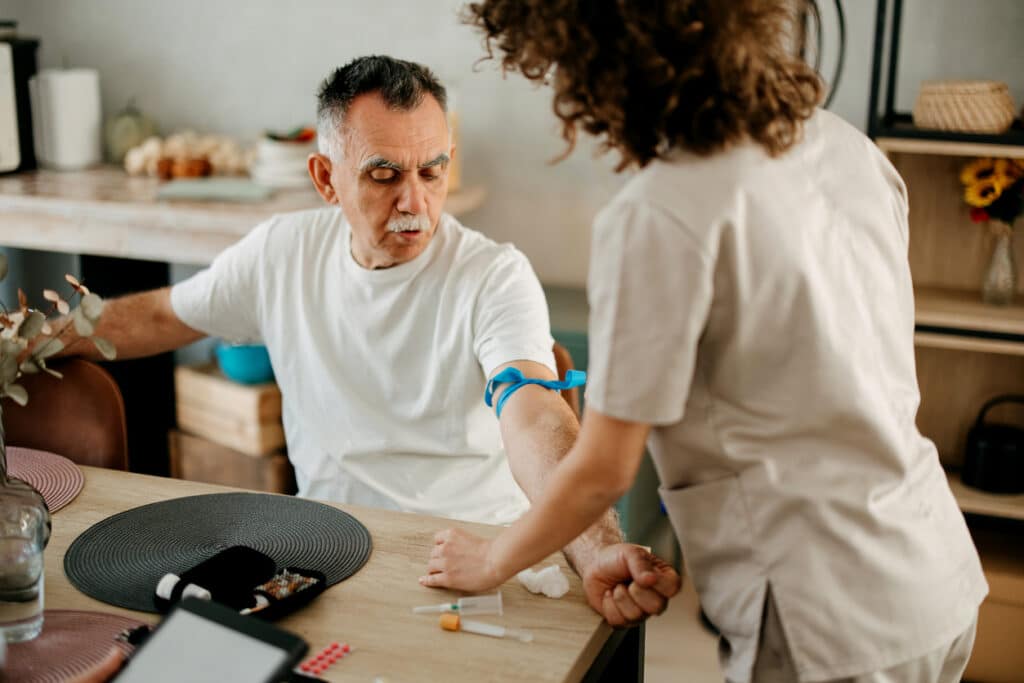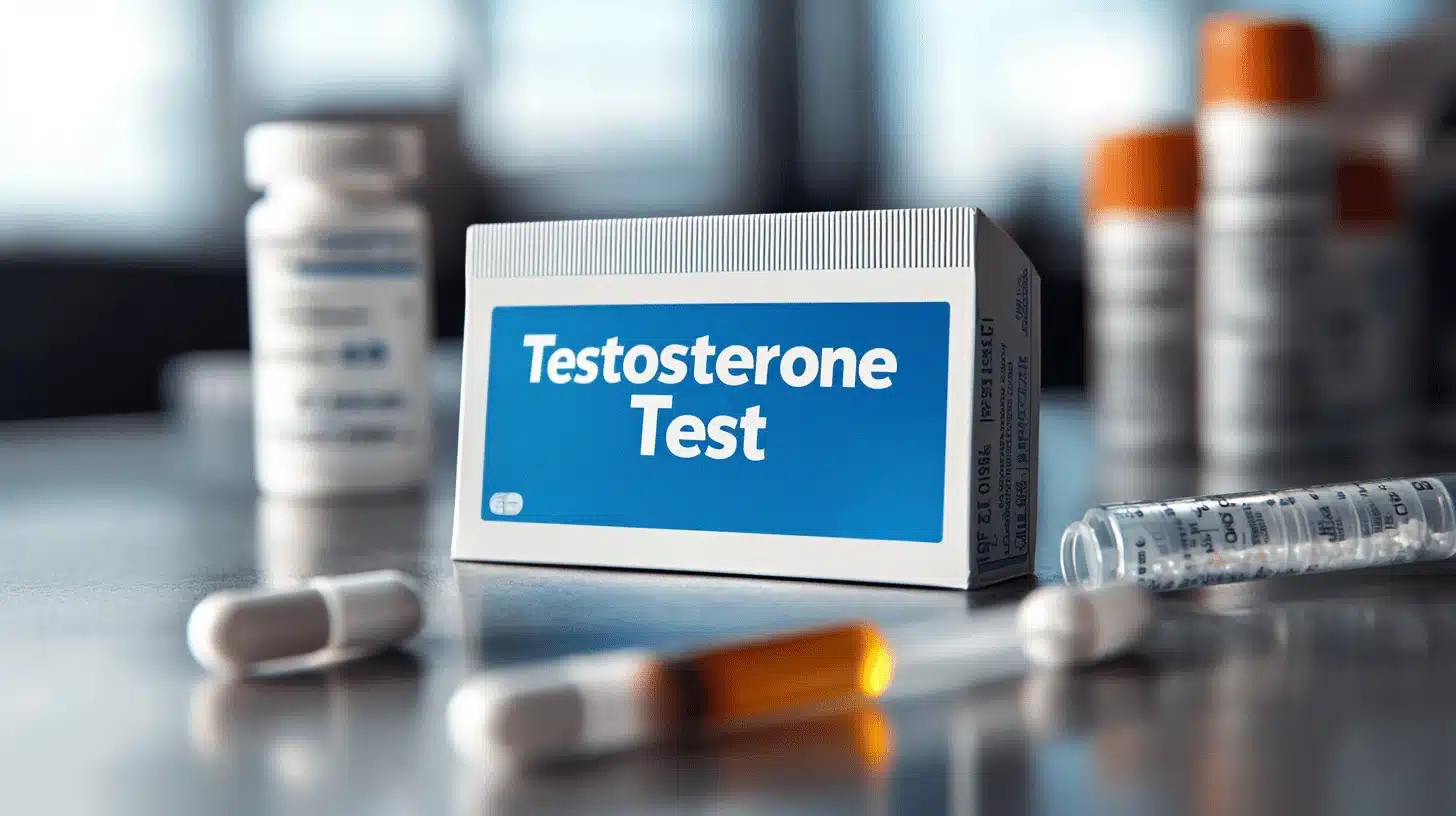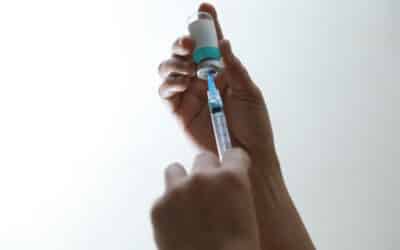In the US, nearly 40% of men over the age of 45 have low testosterone levels? (Source: Cleveland Clinic).
💡A testosterone test is a simple blood test or saliva test that can help you understand why you may be experiencing symptoms like fatigue, low libido, or mood swings due to low testosterone.
By measuring your testosterone levels, you can get a clearer picture of your overall health and determine if low testosterone is affecting your well-being. This guide covers everything you need to know about testosterone testing—from how it works to why it matters.
🤷🏽♂️ Not sure if you need a testosterone test? Take our 2-minute quiz to see if you have the common symptoms of low testosterone and find out your hormonal age.
Understanding Testosterone
What is Testosterone?
Testosterone is a vital sex hormone produced primarily in the testicles in men and in smaller amounts in the ovaries in women. It plays a crucial role in the development of male reproductive tissues and promotes secondary sexual characteristics such as muscle mass, bone density, and hair growth. In women, testosterone helps maintain hormone balance and regulates various bodily functions. This hormone is essential for overall health, influencing everything from physical strength to mood and energy levels.
Normal Testosterone Levels
Normal testosterone levels vary depending on age, sex, and other factors. In adult men, typical testosterone levels range from 300 to 1,000 ng/dL, while in adult women, levels typically fall between 15 and 70 ng/dL. It’s important to note that testosterone levels naturally decline with age. Abnormal testosterone levels, whether too high or too low, can indicate underlying health issues that may require medical attention. Monitoring these levels can provide valuable insights into your health and help identify potential problems early on.
What is a Testosterone Test?
A testosterone test is a medical test that measures the amount of testosterone in your body. In women, testosterone tests can also help diagnose conditions like polycystic ovary syndrome, which is characterized by hormonal imbalances. It is done through a blood or saliva sample and can help determine if your testosterone levels are within a normal range. Testosterone tests can measure both total testosterone (all testosterone in the blood) and free testosterone (the testosterone not bound to proteins like SHBG). These tests are useful in diagnosing symptoms like low energy, decreased muscle mass, and changes in mood or sex drive.
- Blood Draw or Saliva Test? Testosterone levels can be measured with either a blood draw or saliva test, but blood tests are typically more accurate. Expect a visit to your doctor or a clinic, where a quick blood draw will provide the necessary sample.
- Total vs. Free Testosterone: The test will often include measurements for both total testosterone (bound to proteins) and free testosterone (available for use by your body).

Signs You Might Need a Testosterone Test: Symptoms of Low Testosterone
If you’re experiencing these symptoms of low testosterone, it’s time to consider a testosterone test. Here are some of the most common indicators that your testosterone might be low:
- Fatigue: Constant tiredness, even after a good night’s sleep.
- Low Libido: A reduced interest in sex can be a strong indicator of low testosterone.
- Mood Changes: Anxiety, irritability, and even depression could be linked to decreased testosterone levels.
- Loss of Muscle Mass: Struggling to keep or gain muscle despite exercise.
- Weight Gain: Particularly around the abdomen, even with diet control.
🔗 For a comprehensive list of symptoms, check out Mayo Clinic’s guide to low testosterone symptoms.
The Importance of Knowing Your Testosterone Levels
Understanding your testosterone levels is crucial for optimizing health and energy. Here’s why:
- Early Detection: Catch low testosterone before it starts causing major issues.
- Tailored Treatment: If levels are low, you can explore treatment options such as Testosterone Replacement Therapy (TRT) or lifestyle adjustments.
- Track Progress: Measuring your testosterone levels lets you track the impact of treatment or lifestyle changes, making adjustments as needed.
Low testosterone affects more than your libido—it can have a huge impact on mood, sleep, and body composition. Find out more about our testosterone replacement therapy which has helped thousands of men to address their health conditions.
Types of Testosterone Tests
There are several types of testosterone tests, each measuring different aspects of testosterone levels, providing a comprehensive picture of your hormonal health. The most common types are:
| Test Type | Description | Purpose/Importance |
|---|---|---|
| Total Testosterone Test | Measures the total amount of testosterone in the blood, including testosterone bound to proteins such as SHBG and albumin. | Provides an overall view of testosterone levels, as about 98% is bound to proteins and not immediately available for use. |
| Free Testosterone Test | Measures the testosterone that is not bound to any proteins and is available for use by the body. | Shows the active testosterone that tissues are using, useful for understanding symptoms like low libido or decreased energy. |
| Bioavailable Testosterone Test | Measures both free testosterone and testosterone loosely bound to albumin, which is available for biological activity. | Provides a more precise indication of how much testosterone is actively being utilized by the body. |
| Saliva Tests | A non-invasive way to measure testosterone levels, often used in research settings or for convenience. | Less accurate than blood tests, but offers a convenient alternative. |
| SHBG Test | Measures SHBG levels, which can help interpret total testosterone results, especially when free testosterone levels don’t align with symptoms. | SHBG affects the availability of testosterone and can fluctuate due to age, obesity, or thyroid conditions. |
Each type of test provides a different piece of the puzzle, which is why healthcare providers often recommend a combination of these tests to get a comprehensive understanding of your hormonal health. By analyzing both total and free testosterone, along with bioavailable testosterone, you can get a more accurate diagnosis of conditions like hypogonadism or other hormone imbalances.
The type of testosterone test you need depends on your symptoms and what your doctor wants to investigate. A complete panel can give the clearest insight into your health.
Preparing for a Testosterone Test
Preparing for a testosterone test is crucial to ensure accurate results. Since testosterone levels fluctuate throughout the day, it’s recommended to schedule your test early in the morning when levels are at their peak. Avoid strenuous exercise and heavy meals before the test, as these can affect your testosterone levels. Inform your healthcare provider about any medications or supplements you are taking, as some can influence hormone levels. By following these steps, you can help ensure that your test results provide a true reflection of your testosterone levels, allowing for accurate diagnosis and effective treatment planning.
How the Testosterone Test Works: The Role of a Blood Sample
A testosterone levels test is straightforward and efficient. Here’s a breakdown of what to expect:
- Book an Appointment: Visit your healthcare provider or book a telehealth consult to start the process.
- Prepare for the Test: Testosterone levels vary throughout the day—they peak in the morning. For accurate results, schedule the test early in the morning.
- The Blood Draw: Your healthcare provider will collect a small sample of blood, typically from a vein in your arm. The process takes just a few minutes.
- Review Results with Your Doctor: Your doctor will help you interpret the results, discussing the optimal ranges and any potential next steps if levels are low.

What Happens After the Testosterone Test?
Understanding Your Test Results & Typical Ranges
| Test Type | Normal Range | What Results Mean |
|---|---|---|
| Total Testosterone (ng/dL) | Men: 300 – 1,000 ng/dL Women: 15 – 70 ng/dL | Low Total Testosterone: May indicate hypogonadism, fatigue, low libido, or other health issues. High Total Testosterone: May suggest hormonal imbalances or tumors. |
| Free Testosterone (pg/mL) | Men: 9 – 30 pg/mL Women: 0.3 – 1.9 pg/mL | Low Free Testosterone: Can lead to symptoms like low energy, reduced muscle mass, or decreased sexual function. High Free Testosterone: Can indicate hyperandrogenism. |
| Bioavailable Testosterone | Men: 150 – 575 ng/dL Women: 0.3 – 5 pg/mL | Low Bioavailable Testosterone: Suggests the body is not using testosterone efficiently. High Bioavailable Testosterone: Possible cause: conditions like PCOS in women. |
| SHBG (nmol/L) | Men: 10 – 57 nmol/L Women: 18 – 144 nmol/L | Low SHBG: Can increase free testosterone, possibly leading to symptoms of androgen excess. High SHBG: Reduces free testosterone availability, causing deficiency. |
| Saliva Test (pg/mL) | Varies by lab | Low Saliva Testosterone: Can indicate low testosterone but may be less accurate. High Saliva Testosterone: Should be confirmed with blood tests due to lower accuracy. |
Treatment Options if Levels are Low
If your testosterone levels are low, there are multiple treatment routes available.
- Testosterone Replacement Therapy (TRT): This is often the most direct and effective method to restore testosterone levels. Options include topical gels, injections, patches, and pellets. Learn more about Huddle TRT.
- Lifestyle Changes: Regular exercise, strength training, and a healthy diet can help boost testosterone naturally. Foods like leafy greens, fatty fish, and nuts can be great additions.
- Supplements: Zinc, vitamin D, and magnesium are some natural supplements that support testosterone production.
For more information on boosting testosterone naturally, see Healthline’s guide on increasing testosterone. The key is to find a personalized approach that fits your needs—whether it’s therapy, lifestyle changes, or a combination.
Conclusion: Is It Time for a Testosterone Test?
If you’ve been experiencing symptoms like fatigue, low libido, or mood swings, it may be time for a testosterone test. Understanding your testosterone levels is the first step toward feeling like yourself again and optimizing your health for years to come.
A testosterone test can offer valuable insight into your overall health and help you make informed decisions about treatment options, such as testosterone replacement therapy (TRT). Addressing low testosterone levels early can prevent further health issues, improve your quality of life, and support better physical and mental health.
Ready to take the first step? Book a discovery call with Huddle Men’s Health today to find out if testosterone testing and TRT are right for you.
FAQs About Testosterone Tests
What do testosterone tests measure?
Testosterone tests generally measure two forms: total testosterone and free testosterone. Total testosterone includes all the testosterone in the blood, while free testosterone is the amount that is not bound to proteins like sex hormone binding globulin (SHBG). Both types of testosterone levels are important indicators of hormonal balance.
Why would someone need testosterone testing?
You might need testosterone testing if you experience symptoms of abnormal testosterone levels, such as low energy, reduced muscle mass, changes in mood, or decreased sex drive. It can also help identify issues related to adrenal glands or hormone production.
What is sex hormone binding globulin (SHBG) and why is it important?
Sex hormone binding globulin (SHBG) is a protein that binds to testosterone, regulating how much testosterone is available for the body to use. A testosterone test can measure SHBG levels along with testosterone, providing a clearer picture of how much free testosterone is available in your system.
How is testosterone testing performed?
Testosterone testing is done through a blood sample. The blood sample is taken from a vein in your arm and sent to a lab to determine your testosterone levels. It’s important to note that testosterone levels can fluctuate throughout the day, and doctors may recommend testing in the morning for the most accurate results.
What could abnormal testosterone levels indicate?
Abnormal testosterone levels may indicate various health issues. Low testosterone levels could be linked to reduced muscle mass, fatigue, and changes in sexual function, while high levels might be associated with other endocrine or adrenal gland issues. Consulting a healthcare professional is important to understand what your specific testosterone test results mean.
What is the relationship between SHBG and testosterone?
Sex hormone binding globulin (SHBG), sometimes called hormone binding globulin SHBG, affects the amount of free testosterone in your bloodstream. Higher SHBG levels can reduce the amount of available free testosterone, while lower SHBG levels can lead to more free testosterone, potentially causing health changes that need medical attention.




